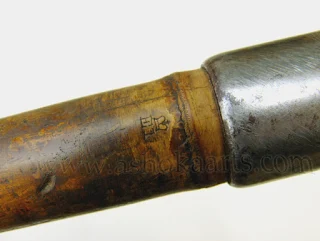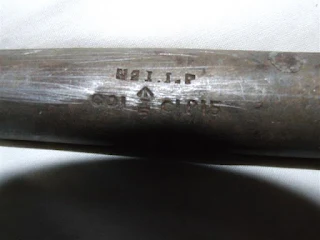Although not of substantially ranked interest, there have been some requests for further knowledge about the
markings appearing on British cavalry lances, both the lancehead and foot (shoe). This
interest apparently was developed as a result of a relatively early article in
this blog; http://arnhemjim.blogspot.com/2011/03/british-pattern-1868-cavalry-lance-at.html
; The British Pattern 1868 Cavalry Lance at Arnhem? Obviously a rather esoteric
subject, it requires a significant search to come up with reliable
authoritative information. Most of the reference data is on the Lance, Cavalry,
Pattern 1868, as it represents to this author’s best understanding the largest
population of lances still in existence, and actual use, albeit in ceremonies
only.
The following photographs first appeared in the above referenced blog article, and are shown again here for the convenience of the reader.
 |
|
British
Pattern 1868 Lancehead and Foot manufactured by Wilkinson Sword Co. Ltd circa 1936 |
 |
|
Wilkinson Sword Co. Ltd etched trademark
on lancehead; no other markings on head or
foot |
 |
| Standard British Army Lance Pennon circa 1900 |
 |
|
Pattern for Lance "Flag" (pennon) for British1868
Pattern
Cavalry Lance
|
The Ordnance List of Changes (LoCs) pertaining to the Pattern 1868 are §4451, §8366 and §9065. These were introduced 6 June 1868. There are several references that this author is aware of, the first being “BRITISH SERVICE SWORD & LANCE PATTERNS”, Pattern Identification, Descriptions & Lists, Official References & Drawings, Accessories & Fittings, I. Skennerton, S.A.I.S. No.6 (Small Arms Identification Series), Published by the author,1994, ISBN 0 646190 36 9.
In another book "THE BROAD ARROW", BRITISH AND EMPIRE Factory Production, Proof, Inspection, Armourers, Unit & Issue Markings, I.D. Skennerton, Published by the author, 2001, ISBN 0 949749 43 5, he states; "Lances were marked with the same indicators (Broad Arrows) on the shoe (foot) above the collar, the marks to be in an upright position. The four patterns of lances had ash or bamboo staves but any unit markings were made on the shoe. Inspector's marks are found on the metal head as well as the shoe." Elsewhere he states, "Lances: Lances were stamped with unit designations and stand numbers on the shoe, above the collar, with the marks in the upright position."
Another reference is the Internet web site; The Sword Forum, http://www.swordforum.com/forums/content.php . Which includes the knowledge, database and participation of Robert Wilkinson-Latham, of Wilkinson Sword Ltd. The visitor has to dig a bit in the forum’s discussions to find data on the subject of lances.
Other references
on the Internet include;
None of these
references provide any further knowledge regarding a standard marking of lances beyond what has been stated. To the best of the author’s
knowledge any further marking was the prerogative of the individual
regiment/unit. The following being an example courtesy of Ashoka Arts (believed
to be in Udaipur India). With full acknowledgement and expressed gratitude, the
firm sold the following pair of Pattern 1868 Lances, attributed to the 13th
Bengal Cavalry (Watsons Horse). Note the difference in pennons, the first being the newer pattern. While an older pattern, because of its apparent physical condition, the second pattern pennon shown may well be a reproduction.
From a gentleman named Nick in Australia the author received information in the comments on four lanceheads he has in a collection. Unfortunately photographs weren’t provided. The first one is marked with [5th”[(possibly 5th Royal Irish Lancers, 5th (Princess Charlotte of Wale’s) Dragoon Guards (ceremonial use) 5th Bengal Cavalry or Probyn’s Horse (5th King Edward’s Own Lancers). Not too definitive, but narrows the “ownership” to four regiments. The second is marked [No. I I.P co ILG 1917 and below 47]. Not much to go on there. The third is marked [5 2], and the fourth marked [No. I I.P] below a Broad Arrow, then M&:C1917]. Other than the date, again not much to go on. The "I.P" stands for Indian Pattern. Some readers may be able to discern additional information from these markings, but at this time the author cannot. These lanceheads however, may have come from the same regiment/unit as some shown in the following photographs, based on the similarity of markings.
In summary a lance will normally have a set of markings on the lancehead comprised of (but not necessarily all);
A manufacturer’s
or arsenal name, mark, or logo (Etched or stamped, i.e., ENFIELD)
• The Mark and Pattern designation (i.e., No. I I.P)
• A form of Broad Arrow (Various styles, some with letters WD)
• An individual inspector’s stamp (Current monarch's crown, letter and number)
• A year of manufacture (i.e., 1915)
• A set of numbers and letter(s)
designating regiment/unit (i.e., 17 L.)
The shoe may
have the following stamped markings (again not necessarily all, perhaps
nothing)
• A manufacturer’s or arsenal name
• A form of Broad Arrow
• An individual inspector’s stamp
• A set of numbers and letter(s)
designating regiment/unit
• A stand/rack number



















No comments:
Post a Comment